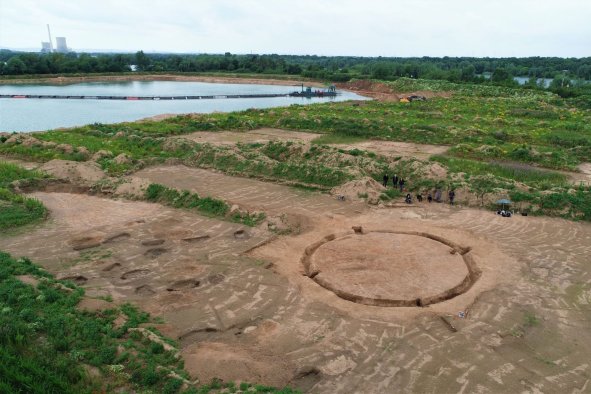The remains of a home believed to date to the late 17th century belonging to an "affluent" owner have been unearthed in Colonial Williamsburg, Virginia.
During an excavation, archaeologists identified the foundation and cellar of the home, as well as other remains and a number of "amazing" artifacts, Jack Gary, the archaeology director at Colonial Williamsburg told Newsweek.
"It's a pretty spectacular site," Gary said. "The artifacts are a really good snapshot of life in Williamsburg at a pretty specific moment in time."
The dig was undertaken amid construction of the Colonial Williamsburg Foundation's upcoming Campbell Archaeology Center, which is slated to open in 2026. In light of the discovery, the Center's architects are now working to reimagine its design to incorporate the newly uncovered archaeological site into the structure.
The house appears to have been constructed just prior to the establishment of the city of Williamsburg in 1699, when the settlement was called Middle Plantation. This unincorporated town was renamed in 1699 to Williamsburg, which served as the capital of the Virginia colony from that year until 1780.
During this period, Virginia was one of the wealthiest and most powerful colonies in North America and played a key role in the American Revolution.
Colonial Williamsburg is a "living history museum"—the largest in the country—that presents part of the historic district. The 301-acre campus includes dozens of original 18th-century buildings, while hundreds of others that were torn down have been recreated. The site also features interpreters and actors walking around to bring the history of Williamsburg to life.
"it really is meant to give the full view of life in 18th century Virginia," Gary said.
The recent excavation found the entire footprint of a historic house, revealing that it was 24 feet by 32 feet in size, according to the archaeologist. In addition to finding the footprint of the building, the team also discovered a well associated with it.
It appears that the house was demolished sometime between 1737 and 1740, Gary said. Based on artifacts that were found in the well, but primarily in the cellar, the team believe its owners were fairly wealthy.
"There have been some amazing artifacts that have come out of the excavations, including an almost intact window from the house—the largest example recovered archaeologically at [Colonial Williamsburg]," Gary said.
"We don't ever find that sort of stuff. It's pretty amazing to have found such a large intact fragment of a window like that," he said.
The window is very fragile so the team decided to carve out the whole block of soil around it and lifted it as one big block of dirt with the window inside. Now it is being kept in a conservation laboratory where the team will conduct what is known as a micro-excavation.
"The household artifacts also point to an affluent household and included a large number of clay wig curlers, a silver teaspoon, and finely decorated ceramics," Gary said. "Not everybody had wigs at that time, although we might think that everyone was walking around in them."
The team also found at least four cowrie shells, small seashells often used as ornaments by slaves.
"Their presence on the site is usually associated with the presence of enslaved people. There were thousands of artifacts recovered from the site and we will return to study them as part of the opening of the new archaeology center," Gary said.
Another find at the site was an "amazing" assemblage of animal bones—the remains of food that was eaten at the house. So far, the bones of pigs, cows, sheep and fish have been identified, but the team is planning to analyze the assemblage further.
It is not yet clear exactly who was living in the house, but the question is still being investigated by the team.
"One of our challenges is that all the property records for this portion of Williamsburg... were burned during the Civil War. So we don't have that property record," Gary said.
Because the team was able to date the destruction of the house to a relatively tight range, the latest finds provide a "fantastic" snapshot into everyday life in Williamsburg from a specific time period, he said.
"A lot of times, we have sites that have been inhabited for long periods of time, and they'll get piled up, they'll get churned up, and so you get everybody's stuff mixed together," Gary said.
"In this case, we've got one occupation that we can look at really specifically, and we excavated everything out of it. That is one of the unique things about this site—that ability to really hone in on a very specific time period and get really good detail about daily life in this one household."
Do you have a tip on a science story that Newsweek should be covering? Do you have a question about archaeology? Let us know via science@newsweek.com.
Disclaimer: The copyright of this article belongs to the original author. Reposting this article is solely for the purpose of information dissemination and does not constitute any investment advice. If there is any infringement, please contact us immediately. We will make corrections or deletions as necessary. Thank you.




